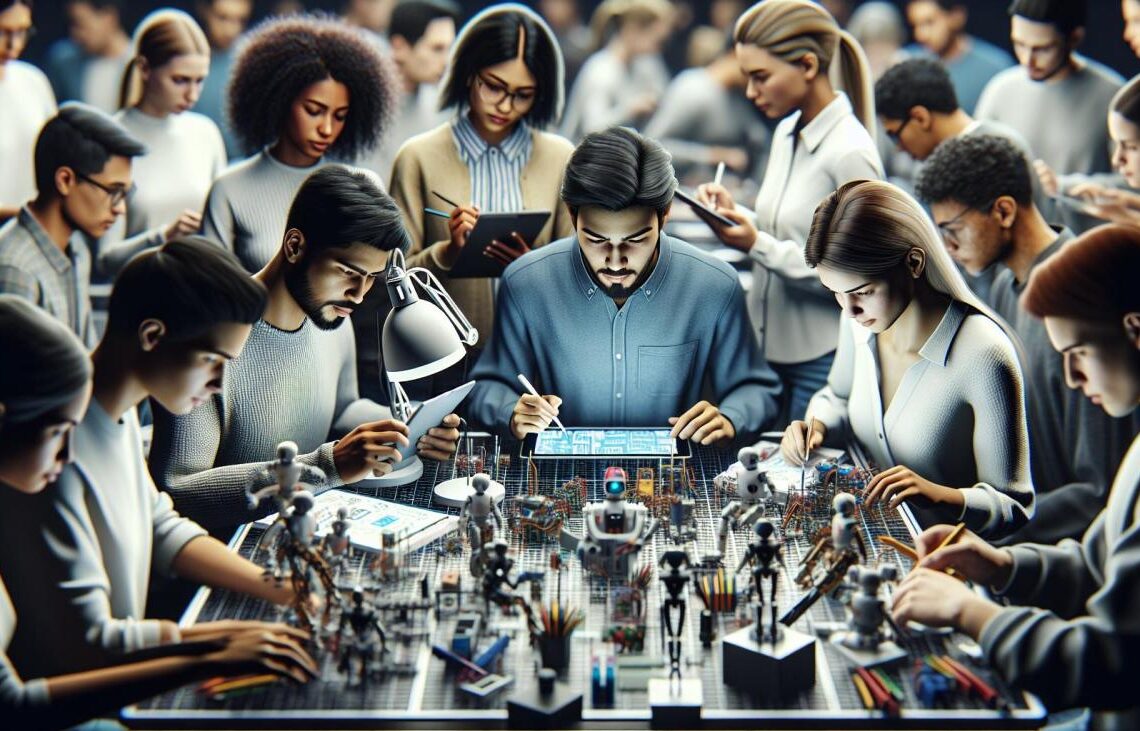In the grand theater of human progress, two protagonists have consistently taken center stage: Technology and Engineering. To the casual observer, these terms might seem interchangeable, floating in the same cloud of innovation and complex machinery. However, they represent two distinct yet profoundly intertwined forces that collectively shape our reality. Technology is the grand vision, the conceptual tool, the answer to the question, “What if we could?” Engineering is the disciplined application, the methodical process, the answer to the critical follow-up, “How do we actually build it?”
This article delves into the dynamic and symbiotic relationship between technology and engineering. We will explore how their collaboration has driven historical milestones, dissect the core engineering disciplines being revolutionized by modern tech, and examine the powerful technological catalysts that are currently rewriting the rules of what is possible. From tackling global challenges like climate change to envisioning a future of unparalleled advancement, the partnership between the technologist’s dream and the engineer’s blueprint is the engine of our civilization. This is the story of how ideas are transformed into the tangible world we inhabit, a testament to human ingenuity that continues to forge our collective future.
The Fundamental Synergy: Vision Meets Execution
Understanding the core of this partnership requires seeing it not as a merger, but as a perpetual feedback loop. Technology provides the goal, while engineering provides the path.
Imagine the concept of global, instantaneous communication. That concept is a piece of technology. The engineers—electrical, computer, and software engineers—are the ones who design the fiber-optic cables, build the transmission towers, write the complex code for data packets, and create the physical smartphones that make this technological dream a functional reality.
Conversely, the tools developed by engineers often give birth to entirely new technological possibilities. The creation of the microprocessor (an engineering feat) unlocked the entire technological revolution of personal computing. The development of efficient solar panels (an engineering challenge) has made the technology of renewable energy viable on a global scale.
In essence:
- Technology is the application of scientific knowledge for practical purposes. It is the “what” and the “why.” It’s the invention, the concept, the system, and the method.
- Engineering is the application of scientific and mathematical principles to design, build, and maintain structures, machines, materials, and processes. It is the “how.” It’s the design, the build, the test, and the implementation.
Without engineering, technology remains a collection of brilliant but unrealized ideas. Without the push of new technology, engineering can become stagnant, merely optimizing old solutions instead of creating new ones. Their synergy is what turns science fiction into scientific fact.
A Historical Panorama: Milestones of a Powerful Alliance
The collaboration between technology and engineering is not a recent phenomenon. It is a golden thread running through the tapestry of human history, with each knot representing a monumental leap forward.
- The Industrial Revolution: The technology of steam power, conceptualized by thinkers and scientists, was brought to life by mechanical engineers like James Watt. They didn’t just invent an engine; they engineered it to be efficient, reliable, and scalable. This collaboration powered factories, revolutionized transport with trains and steamships, and fundamentally reshaped society.
- The Age of Electrification: The scientific discovery of electricity was a technological breakthrough. But it was the tireless work of electrical engineers that created the entire infrastructure we now take for granted. They designed power grids, engineered safe wiring for homes, and developed the motors and light bulbs that brought this technology into every corner of life.
- The Conquest of the Skies and Space: The dream of flight is an ancient technology. Aerospace engineers made it a reality. From the Wright brothers meticulously engineering their flyer to the thousands of engineers who designed the Saturn V rocket, this field is a testament to applying rigorous principles to achieve a technological goal. They battled physics, developed new materials, and engineered complex life-support systems to take humanity beyond its terrestrial confines.
- The Digital Age: The concept of a calculating machine (the technology of computing) existed for centuries. It took computer and software engineers to create the physical hardware—transistors, integrated circuits, and CPUs—and the logical software—operating systems, programming languages, and applications—that define our modern world. Every app, website, and digital device is a product of this ongoing engineering endeavor.
Core Disciplines of Modern Engineering: A Technological Renaissance
Today, almost no field of engineering remains untouched by the rapid advancements in technology. Here is a look at several core disciplines and how they are being transformed.
A. Civil Engineering The discipline responsible for the built environment—roads, bridges, dams, and cities—is undergoing a digital overhaul. Drones and LiDAR technology are used for highly accurate surveying and site inspection. Building Information Modeling (BIM) software allows engineers to create detailed 3D digital twins of structures, enabling them to simulate stress, optimize material usage, and identify potential conflicts before a single shovel breaks ground. Smart sensors embedded in bridges and buildings provide real-time data on structural integrity, revolutionizing maintenance and safety.
B. Mechanical Engineering This broad field, dealing with machinery, thermodynamics, and motion, is at the heart of automation and advanced manufacturing. Computer-Aided Design (CAD) and Computer-Aided Engineering (CAE) are standard tools, allowing for the rapid prototyping and virtual testing of everything from car engines to robotic arms. The rise of the Internet of Things (IoT) has led to “smart” machines that can predict their own maintenance needs, while 3D printing is enabling the creation of complex, lightweight parts that were previously impossible to manufacture.
C. Electrical Engineering Beyond traditional power grids, electrical engineers are now at the forefront of renewable energy, designing more efficient solar panels, wind turbines, and battery storage systems. In electronics, they are pushing the boundaries of miniaturization to create smaller, more powerful processors for our devices. The development of the smart grid, a technology that uses real-time communication to balance energy supply and demand, is a monumental task for modern electrical engineers.
D. Chemical Engineering Chemical engineers, who traditionally designed processes for large-scale chemical manufacturing, are now leveraging technology to work at the molecular level. They are using advanced simulation software to develop new catalysts and pharmaceuticals. They are also central to the green revolution, engineering new biodegradable plastics, creating more efficient biofuels, and developing carbon capture technologies to combat climate change.
E. Computer & Software Engineering This is perhaps the most visibly fast-moving discipline. Computer engineers design the hardware that powers our digital world, from quantum computing prototypes to neuromorphic chips that mimic the human brain. Software engineers are the architects of the digital experience, building the massive, scalable cloud platforms, the complex artificial intelligence algorithms, and the secure blockchain systems that are transforming every industry. The rise of DevOps and agile methodologies has further integrated the process of software creation and deployment.
F. Aerospace Engineering This field is being propelled by computational fluid dynamics (CFD) for designing more aerodynamic and fuel-efficient aircraft. Engineers are developing lightweight composite materials to reduce weight and increase strength. In the realm of space exploration, they are designing reusable rockets, autonomous interplanetary probes, and sophisticated satellite constellations that provide global internet coverage.
G. Biomedical Engineering At the intersection of medicine and engineering, this field is a hotbed of technological fusion. Engineers are using 3D printing to create custom prosthetics and even biological tissue (bioprinting). They design sophisticated medical devices like MRI machines, pacemakers, and robotic surgical systems. In bioinformatics, they apply software engineering principles to analyze vast datasets of genomic information, paving the way for personalized medicine.
The Technological Catalysts Revolutionizing Engineering

While engineering disciplines are the canvas, a handful of key technologies act as the vibrant paints, adding new colors and textures to what can be created.
A. Artificial Intelligence (AI) and Machine Learning (ML) AI is arguably the most significant catalyst. In engineering, ML algorithms can analyze vast datasets from simulations or physical sensors to optimize designs, predict equipment failures, and discover new materials. Generative design, a subfield of AI, allows engineers to input goals and constraints, after which the AI explores thousands of design permutations to find the most optimal solution, often resulting in unconventional but highly efficient forms.
B. The Internet of Things (IoT) IoT refers to the network of physical devices embedded with sensors and software that connect and exchange data. For engineers, this means creating and managing systems that are constantly “talking.” A civil engineer can monitor an entire city’s water system in real-time. A mechanical engineer can get performance data from a jet engine mid-flight. An agricultural engineer can use soil sensors to create automated, precision irrigation systems.
C. Big Data and Analytics The sensors from IoT and the simulations from design software generate an astronomical amount of data. Big Data technologies provide the means to store and process this information. Data analytics allows engineers to extract meaningful insights from it, moving from reactive problem-solving to proactive, data-driven decision-making.
D. 3D Printing (Additive Manufacturing) This technology is shifting the paradigm from subtractive manufacturing (cutting away material) to additive (building up layer by layer). For engineers, this means unprecedented design freedom. It allows for the creation of intricate internal geometries for cooling or strength, the rapid production of prototypes, and on-demand manufacturing of spare parts in remote locations, like on a naval ship or even the International Space Station.
E. Robotics and Automation From the factory floor to the operating room, robotics is extending the reach and precision of engineers. Industrial robots perform repetitive, high-precision tasks 24/7. In hazardous environments, like nuclear decommissioning or deep-sea exploration, robots engineered for the task can go where humans cannot. Collaborative robots (“cobots”) are now being designed to work alongside human engineers, augmenting their capabilities.
F. Cloud Computing The immense computational power needed for modern engineering simulations (like CFD or finite element analysis) is often beyond the capacity of a single workstation. Cloud computing gives engineers access to virtually limitless supercomputing power on a pay-as-you-go basis. It also facilitates global collaboration, allowing teams of engineers from different continents to work on the same massive digital models in real-time.
Facing Global Challenges: Engineering for a Better World
The potent combination of technology and engineering is humanity’s greatest asset in confronting the major challenges of the 21st century.
- Sustainable Development: Engineers are at the heart of the transition to a sustainable future. They are designing next-generation renewable energy systems, engineering smart grids to manage power efficiently, creating sustainable water purification and distribution systems, and designing green buildings with minimal carbon footprints.
- Advanced Healthcare: As discussed in biomedical engineering, the fusion of tech and engineering is personalizing medicine, making surgery less invasive, and providing better diagnostic tools. Wearable sensor technology, engineered for comfort and accuracy, allows for continuous health monitoring, shifting the focus from treatment to prevention.
- Smart Cities: The concept of a “smart city” is an enormous engineering project. It involves integrating technology into every facet of urban life. Civil engineers design intelligent transportation systems to reduce congestion. Environmental engineers deploy sensor networks to monitor air and water quality. Software engineers build the central platforms that allow city managers to visualize and manage all these interconnected systems.
The Future Horizon: What Awaits?

The synergy between technology and engineering is accelerating, pointing toward a future that is both exciting and transformative.
- Quantum Computing: While still in its infancy, quantum computing promises to provide computational power that will dwarf even today’s supercomputers. For engineers, this could mean simulating molecular interactions with perfect accuracy, leading to the discovery of revolutionary new materials and drugs.
- Human-Computer Integration: The lines will continue to blur. Brain-Computer Interfaces (BCIs), developed by neuro- and computer engineers, could allow people to control advanced prosthetics or interact with digital systems with their thoughts alone.
- Autonomous Everything: We are at the beginning of the autonomous revolution. Self-driving cars are just the start. We can expect fully autonomous shipping, automated construction sites managed by robotic engineers, and AI-driven systems that manage our global logistics networks.
- Space Colonization: The ultimate engineering challenge may be establishing a permanent, self-sustaining human presence on another planet. This will require every discipline of engineering, from aerospace and civil to chemical and biomedical, working in concert with the most advanced AI and robotics technologies imaginable.
The Architects of Tomorrow
Technology and engineering are not merely fields of study; they are acts of creation. They are the twin forces that have lifted humanity from caves to skyscrapers, from signal fires to global fiber-optic networks. Technology provides the spark of imagination, the ambitious dream of a better way. Engineering provides the discipline, the knowledge, and the relentless effort to hammer that dream into a solid, functional, and reliable reality.
As we look toward the complex challenges and breathtaking opportunities of the future, this partnership will become more critical than ever. The solutions to our greatest problems and the keys to our grandest ambitions lie at the intersection of these two domains. The future is not something that simply happens to us; it is something that is built. And its architects, today as always, are the technologists and engineers working together to forge our world, one brilliant idea and one meticulously engineered solution at a time.














